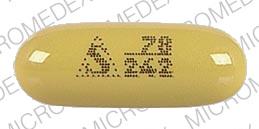Sandimmune and Alcohol/Food Interactions
There are 2 alcohol/food/lifestyle interactions with Sandimmune (cyclosporine).
Cyclosporine Food/Lifestyle
Moderate Food Interaction
GENERALLY AVOID: Administration with grapefruit juice (compared to water or orange juice) has been shown to increase blood concentrations of cyclosporine with a relatively high degree of interpatient variability. The mechanism is inhibition of CYP450 3A4-mediated first-pass metabolism in the gut wall by certain compounds present in grapefruits.
GENERALLY AVOID: Administration with red wine or purple grape juice may decrease blood concentrations of cyclosporine. In 12 healthy volunteers, 12 ounces total of a merlot consumed 15 minutes prior to and during cyclosporine administration (single 8 mg/kg dose of Sandimmune) decreased cyclosporine peak blood concentration (Cmax) and systemic exposure (AUC) by 38% and 30%, respectively, compared to water. The time to reach peak concentration (Tmax) doubled, and oral clearance increased 50%. Similarly, one study were 12 healthy patients were administered purple grape juice and a single dose of cyclosporine showed a 30% and a 36% decrease in cyclosporine systemic exposure (AUC) and peak blood concentration (Cmax), respectively. The exact mechanism of interaction is unknown but may involve decreased cyclosporine absorption.
MONITOR: Food has been found to have variable effects on the absorption of cyclosporine. There have been reports of impaired, unchanged, and enhanced absorption during administration with meals relative to the fasting state. The mechanisms are unclear. Some investigators found an association with the fat content of food. In one study, increased fat intake resulted in significantly increased cyclosporine bioavailability and clearance. However, the AUC and pharmacodynamics of cyclosporine were not significantly affected, thus clinical relevance of these findings may be minimal.
MANAGEMENT: Patients receiving cyclosporine therapy should be advised to either refrain from or avoid fluctuations in the consumption of grapefruits and grapefruit juice. Until more data are available, the consumption of red wine or purple grape juice should preferably be avoided or limited. All oral formulations of cyclosporine should be administered on a consistent schedule with regard to time of day and relation to meals so as to avoid large fluctuations in plasma drug levels.
References (13)
- Honcharik N, Yatscoff RW, Jeffery JR, Rush DN (1991) "The effect of meal composition on cyclosporine absorption." Transplantation, 52, p. 1087-9
- Ducharme MP, Provenzano R, Dehoornesmith M, Edwards DJ (1993) "Trough concentrations of cyclosporine in blood following administration with grapefruit juice." Br J Clin Pharmacol, 36, p. 457-9
- Bailey DG, Arnold JMO, Spence JD (1994) "Grapefruit juice and drugs - how significant is the interaction." Clin Pharmacokinet, 26, p. 91-8
- Hollander AAMJ, Vanrooij J, Lentjes EGWM, Arbouw F, Vanbree JB, Schoemaker RC, Vanes LA, Vanderwoude FJ, Cohen AF (1995) "The effect of grapefruit juice on cyclosporine and prednisone metabolism in transplant patients." Clin Pharmacol Ther, 57, p. 318-24
- (1995) "Grapefruit juice interactions with drugs." Med Lett Drugs Ther, 37, p. 73-4
- Tan KKC, Trull AK, Uttridge JA, Metcalfe S, Heyes CS, Facey S, Evans DB (1995) "Effect of dietary fat on the pharmacokinetics and pharmacodynamics of cyclosporine in kidney transplant recipients." Clin Pharmacol Ther, 57, p. 425-33
- Yee GC, Stanley DL, Pessa LJ, et al. (1995) "Effect of grrapefruit juice on blood cyclosporin concentration." Lancet, 345, p. 955-6
- Ducharme MP, Warbasse LH, Edwards DJ (1995) "Disposition of intravenous and oral cyclosporine after administration with grapefruit juice." Clin Pharmacol Ther, 57, p. 485-91
- Ioannidesdemos LL, Christophidis N, Ryan P, Angelis P, Liolios L, Mclean AJ (1997) "Dosing implications of a clinical interaction between grapefruit juice and cyclosporine and metabolite concentrations in patients with autoimmune diseases." J Rheumatol, 24, p. 49-54
- Min DI, Ku YM, Perry PJ, Ukah FO, Ashton K, Martin MF, Hunsicker LG (1996) "Effect of grapefruit juice on cyclosporine pharmacokinetics in renal transplant patients." Transplantation, 62, p. 123-5
- Bailey DG, Dresser GR, Kreeft JH, Munoz C, Freeman DJ, Bend JR (2000) "Grapefruit-felodipine interaction: Effect of unprocessed fruit and probable active ingredients." Clin Pharmacol Ther, 68, p. 468-77
- Tsunoda SM, Harris RZ, Christians U, et al. (2001) "Red wine decreases cyclosporine bioavailability." Clin Pharmacol Ther, 70, p. 462-7
- Oliveira-Freitas VL, Dalla Costa T, Manfro RC, Cruz LB, Schwartsmann G (2010) "Influence of purple grape juice in cyclosporine availability." J Ren Nutr, 20, p. 309-13
Switch to consumer interaction data
Cyclosporine High Blood Pressure (Hypertension)
Major Potential Hazard, High plausibility
cyclosporine - hypertension
The use of cyclosporine is contraindicated in patients with rheumatoid arthritis or psoriasis with uncontrolled hypertension. Hypertension, possibly due to renal vasoconstriction, has occurred in 50% of patients receiving cyclosporine. Antihypertensive therapy may be necessary for kidney, liver, and heart transplant recipients treated with cyclosporine. Hypertension may decline with continued used, but has persisted in some patients.
References (3)
- (2022) "Product Information. SandIMMUNE (cycloSPORINE)." Apothecon Inc
- Textor SC, Canzanello VJ, Taler SJ, Wilson DJ, Schwartz LL, Augustine JE, Raymer JM, Romero JC, Wiesner RH, Krom RAF, B (1994) "Cyclosporine-induced hypertension after transplantation." Mayo Clin Proc, 69, p. 1182-93
- "Product Information. Neoral (cycloSPORINE)." Sandoz Pharmaceuticals Corporation
Switch to consumer interaction data
Sandimmune drug interactions
There are 828 drug interactions with Sandimmune (cyclosporine).
Sandimmune disease interactions
There are 4 disease interactions with Sandimmune (cyclosporine) which include:
More about Sandimmune (cyclosporine)
- Sandimmune consumer information
- Check interactions
- Compare alternatives
- Pricing & coupons
- Drug images
- Latest FDA alerts (3)
- Side effects
- Dosage information
- During pregnancy
- Generic availability
- Drug class: calcineurin inhibitors
- Breastfeeding
- En español
Related treatment guides
Drug Interaction Classification
| Highly clinically significant. Avoid combinations; the risk of the interaction outweighs the benefit. | |
| Moderately clinically significant. Usually avoid combinations; use it only under special circumstances. | |
| Minimally clinically significant. Minimize risk; assess risk and consider an alternative drug, take steps to circumvent the interaction risk and/or institute a monitoring plan. | |
| No interaction information available. |
See also:
Further information
Always consult your healthcare provider to ensure the information displayed on this page applies to your personal circumstances.


